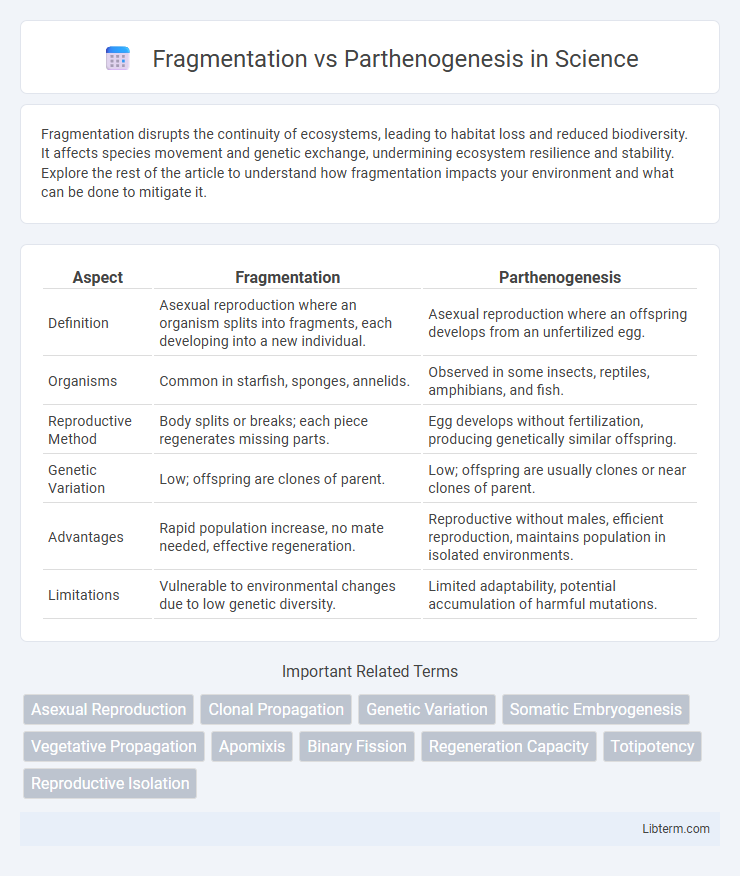Fragmentation disrupts the continuity of ecosystems, leading to habitat loss and reduced biodiversity. It affects species movement and genetic exchange, undermining ecosystem resilience and stability. Explore the rest of the article to understand how fragmentation impacts your environment and what can be done to mitigate it.
Table of Comparison
| Aspect | Fragmentation | Parthenogenesis |
|---|---|---|
| Definition | Asexual reproduction where an organism splits into fragments, each developing into a new individual. | Asexual reproduction where an offspring develops from an unfertilized egg. |
| Organisms | Common in starfish, sponges, annelids. | Observed in some insects, reptiles, amphibians, and fish. |
| Reproductive Method | Body splits or breaks; each piece regenerates missing parts. | Egg develops without fertilization, producing genetically similar offspring. |
| Genetic Variation | Low; offspring are clones of parent. | Low; offspring are usually clones or near clones of parent. |
| Advantages | Rapid population increase, no mate needed, effective regeneration. | Reproductive without males, efficient reproduction, maintains population in isolated environments. |
| Limitations | Vulnerable to environmental changes due to low genetic diversity. | Limited adaptability, potential accumulation of harmful mutations. |
Understanding Fragmentation and Parthenogenesis
Fragmentation is a form of asexual reproduction where an organism splits into fragments, each capable of developing into a fully functional individual, commonly observed in species like starfish and some annelids. Parthenogenesis involves the development of an embryo from an unfertilized egg, found in various insects, reptiles, and amphibians, allowing population increase without mating. Understanding fragmentation and parthenogenesis reveals diverse evolutionary strategies for survival and reproduction in environments with limited mates or harsh conditions.
Key Differences Between Fragmentation and Parthenogenesis
Fragmentation involves an organism splitting into two or more separate entities that regenerate into complete individuals, whereas parthenogenesis is a form of asexual reproduction where an organism develops from an unfertilized egg. Fragmentation requires the organism to physically divide, commonly observed in species like starfish and certain annelids, while parthenogenesis occurs in species such as aphids and some reptiles without the need for division or mating. The genetic variation in fragmentation depends on the organism's ability to regenerate, while parthenogenesis typically produces genetically identical offspring unless mutations occur.
Biological Mechanisms of Fragmentation
Fragmentation is an asexual reproduction mechanism where an organism breaks into two or more parts, each capable of growing into a complete individual, common in species like starfish and spirogyra. This process relies on the regeneration capacity of somatic cells, involving cellular dedifferentiation and proliferation at the wound site to restore lost tissues. Parthenogenesis, in contrast, involves the development of an embryo from an unfertilized egg, bypassing the need for fragmentation or cellular regeneration.
Biological Mechanisms of Parthenogenesis
Parthenogenesis is an asexual reproductive mechanism where an organism develops from an unfertilized egg, bypassing the need for sperm, unlike fragmentation which involves the organism splitting into parts that regenerate into new individuals. The biological mechanisms of parthenogenesis include automixis and apomixis, where automixis involves meiosis followed by the restoration of diploidy, and apomixis entails mitotic division producing offspring genetically identical to the mother. Parthenogenetic reproduction is observed in various species such as certain reptiles, insects, and plants, allowing rapid population increase without genetic contribution from a male.
Examples of Organisms Practicing Fragmentation
Starfish and planarians are prime examples of organisms practicing fragmentation, where a single individual can regenerate into multiple complete organisms from body fragments. Many annelid worms, such as Tubifex, also reproduce through fragmentation, splitting their bodies to form new individuals. This asexual reproduction method enhances population survival and rapid colonization in stable environments without the need for fertilization.
Examples of Organisms Exhibiting Parthenogenesis
Parthenogenesis is a form of asexual reproduction where offspring develop from unfertilized eggs, commonly observed in organisms such as aphids, stick insects, and certain species of sharks like the bonnethead. Unlike fragmentation, which involves the organism splitting into parts that regenerate into new individuals, parthenogenesis allows female organisms to reproduce without male genetic contribution, ensuring rapid population growth in stable environments. This reproductive strategy is also seen in some reptiles, including whiptail lizards, enabling them to populate areas with limited male presence.
Evolutionary Advantages and Disadvantages
Fragmentation allows for rapid population increase and genetic diversity through sexual reproduction, providing adaptability to changing environments but requires more energy and mates. Parthenogenesis enables reproduction without fertilization, offering quick colonization and survival in isolated conditions, yet results in low genetic variation, limiting evolutionary potential. Both methods present trade-offs between reproductive efficiency and genetic diversity influencing species survival strategies.
Ecological Impacts and Adaptations
Fragmentation allows rapid population growth and colonization in stable environments by producing genetically identical offspring, enhancing local adaptation but reducing genetic diversity. Parthenogenesis enables reproduction without mates, promoting survival in isolated or low-density populations and facilitating rapid expansion with limited resource competition. Both strategies influence ecosystem dynamics by altering species distribution, competition, and resilience to environmental changes.
Fragmentation and Parthenogenesis in Biotechnology
Fragmentation is a biotechnological method of asexual reproduction where an organism is split into fragments, each capable of developing into a new individual, widely used in cloning plants and regenerating tissues. Parthenogenesis involves the development of an embryo from an unfertilized egg and is exploited in biotechnology to produce homozygous lines and genetically uniform populations, especially in insects and some vertebrates. Both techniques enhance genetic stability and rapid population expansion, crucial for agricultural biotechnology and conservation efforts.
Future Research and Applications
Future research on fragmentation and parthenogenesis explores genetic and epigenetic mechanisms underlying these asexual reproduction methods, aiming to enhance regenerative medicine and agricultural biotechnology. Advances in CRISPR gene editing and single-cell sequencing will elucidate cellular differentiation pathways, promoting cloning efficiency and crop improvement. Potential applications include developing disease-resistant plant varieties and regenerating damaged tissues in clinical therapies.
Fragmentation Infographic

 libterm.com
libterm.com